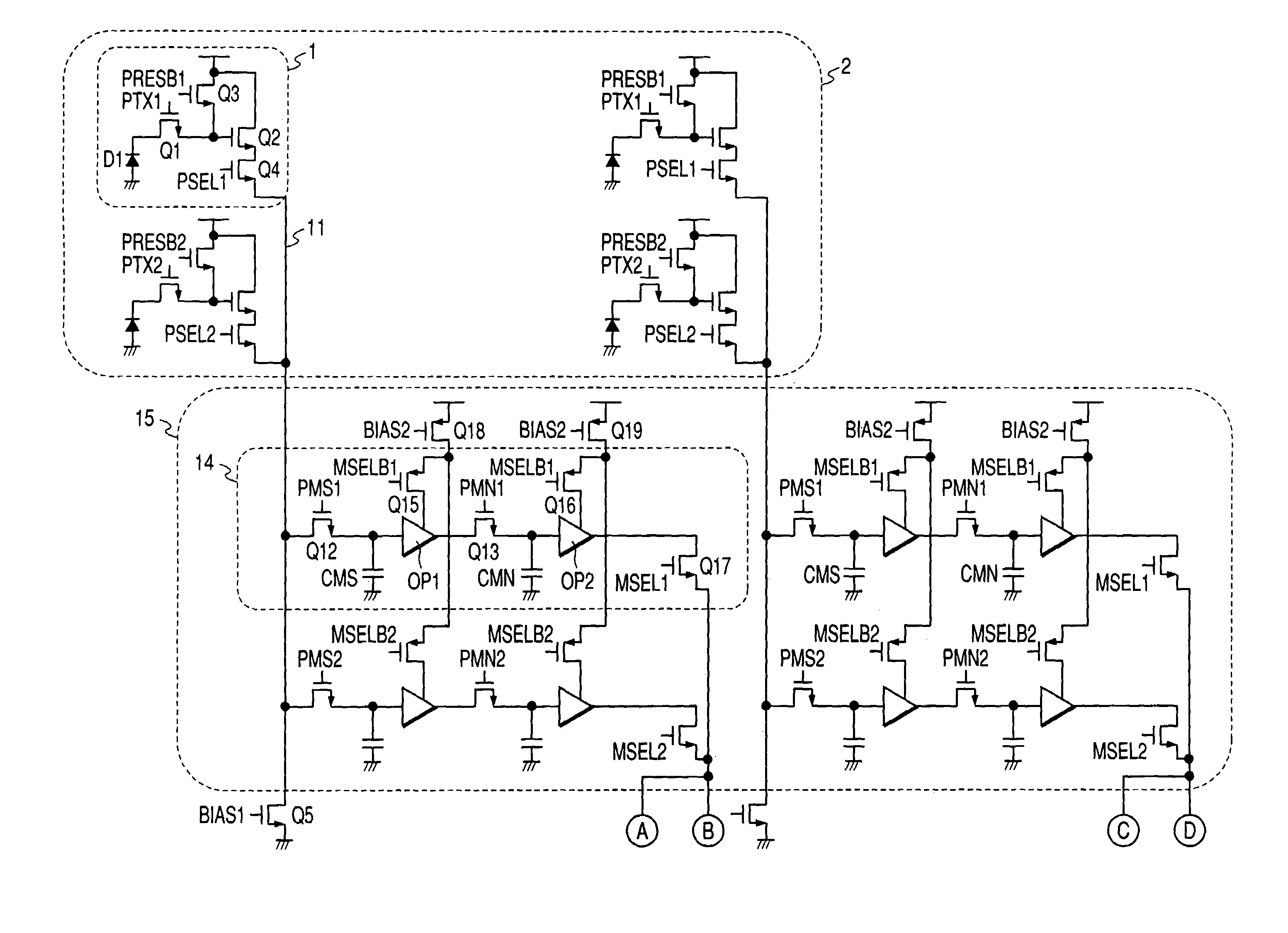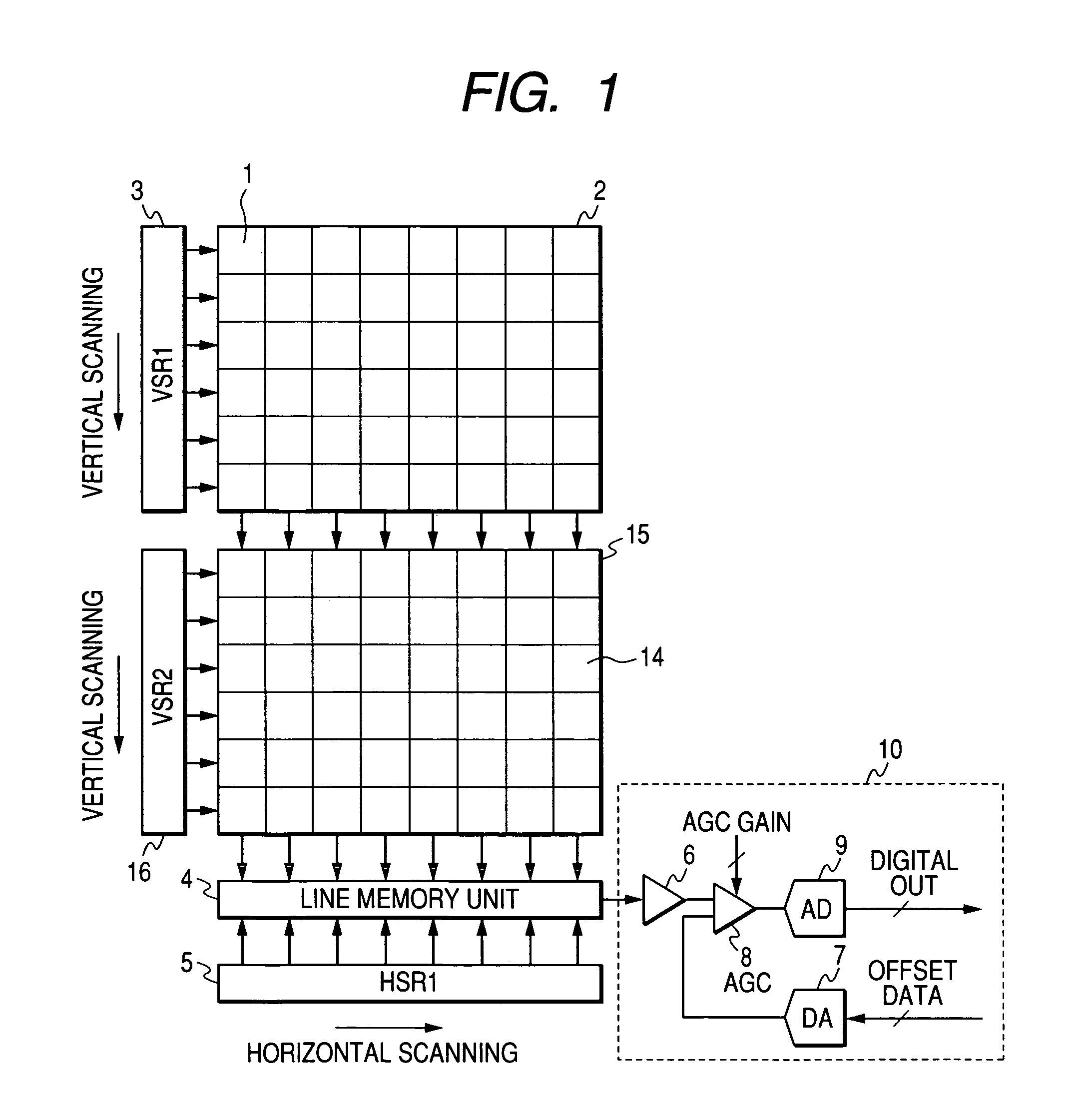Solid state image device and camera using it
a solid-state image and image technology, applied in the field of solid-state image devices, can solve the problems of deteriorating image quality, affecting the quality of images, so as to improve the s/n proportion, improve the s/n ratio, and improve the effect of features
- Summary
- Abstract
- Description
- Claims
- Application Information
AI Technical Summary
Benefits of technology
Problems solved by technology
Method used
Image
Examples
first embodiment
[0044]FIG. 1 is a block diagram showing a first embodiment of a solid state image device related to the present invention. Here, in FIG. 1, like reference characters designate the same parts in FIG. 10 and descriptions thereon will be omitted. FIG. 1 is different from FIG. 10 in that a frame memory unit 15 with memory element 14 being two-dimensionally arranged equivalent to the photoelectric conversion unit 2 and a second vertical shift register 16 (VSR2) to drive the frame memory unit 15 are present behind the photoelectric conversion unit 2. Here, the arrangement of the pixels and the memory elements is 6 rows by 8 columns, but the arrangement will not be limited thereto but is optional.
[0045]In addition, each pixel of the photoelectric conversion unit 2 corresponds one-to-one with each memory element of the frame memory 15 so that the output of each row of the photoelectric conversion unit 2 selected by the first vertical shift register 3 is respectively stored in the memory ele...
second embodiment
[0065]FIG. 5 is a block diagram showing a second embodiment of the present invention. Here, in FIG. 5, like reference characters designate the same parts in FIG. 1 and descriptions thereon will be omitted. FIG. 5 is different from FIG. 1 in that a photoelectric conversion unit 2 and a frame memory unit 15 respectively have second vertical shift registers 17 and 18. Moreover, FIG. 5 is different from FIG. 1 in that a second line memory 19, a horizontal shift register 20 and operational amplifiers 6 are present and outputs of the first and the second operational amplifiers 6 are selected by a switch 21 and inputted to a gain control amplifier 8. Here, the arrangement of the pixels and the memory elements is 6 rows by 8 columns, but the arrangement will not be limited thereto but is optional.
[0066]In addition, these two units each of the vertical shift registers 3, 17 and 16, 18 are driven by shift pulses with 180-degree phase discrepancy and operate so as to select the photoelectric c...
third embodiment
[0077]FIG. 9 is a block diagram showing an embodiment of a still camera with a solid state image device of the present invention as described above. In FIG. 9, reference numeral 101 denotes a barrier that combines protection of a lens and a main switch, reference numeral 102 denotes a lens of forming an optical image of an object into a solid state image device 104, reference numeral 103 denotes a diaphragm of varying a light quantity that has passed the lens 102 and reference numeral 104 denotes a solid state image device for taking in an object that has undergone image forming with the lens 102 as an image signal. The solid state image device 104 corresponds with the solid state image device of the present invention described above.
[0078]Reference numeral 106 denotes an A / D converter of implementing digital-analogue conversion on the image signal outputted from the solid state image device 104. Reference numeral 107 denotes a signal processing unit of implementing respective kinds...
PUM
 Login to View More
Login to View More Abstract
Description
Claims
Application Information
 Login to View More
Login to View More - R&D
- Intellectual Property
- Life Sciences
- Materials
- Tech Scout
- Unparalleled Data Quality
- Higher Quality Content
- 60% Fewer Hallucinations
Browse by: Latest US Patents, China's latest patents, Technical Efficacy Thesaurus, Application Domain, Technology Topic, Popular Technical Reports.
© 2025 PatSnap. All rights reserved.Legal|Privacy policy|Modern Slavery Act Transparency Statement|Sitemap|About US| Contact US: help@patsnap.com



